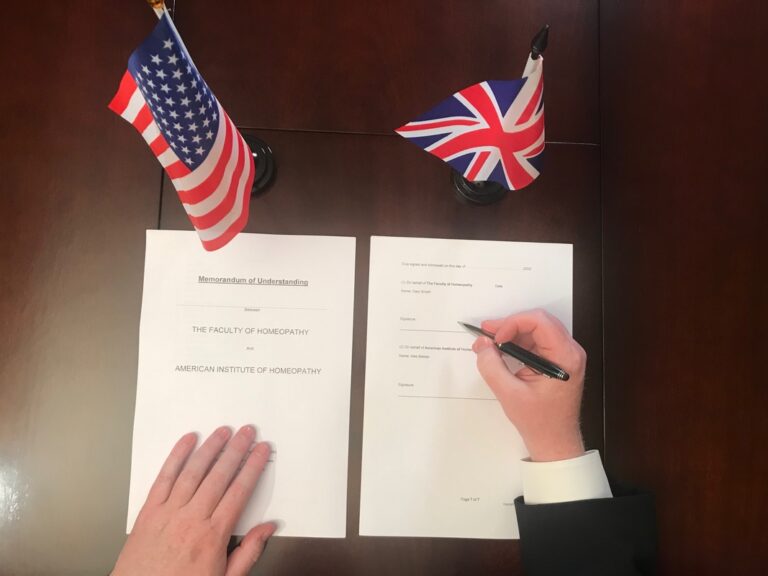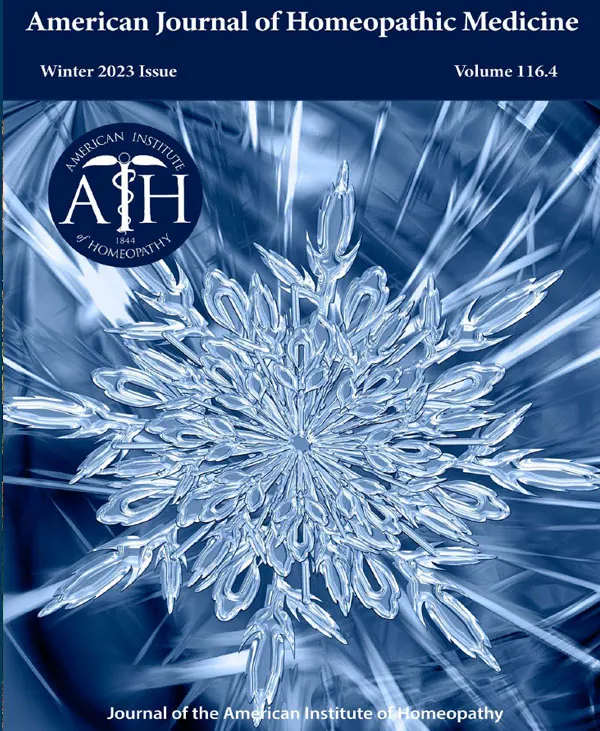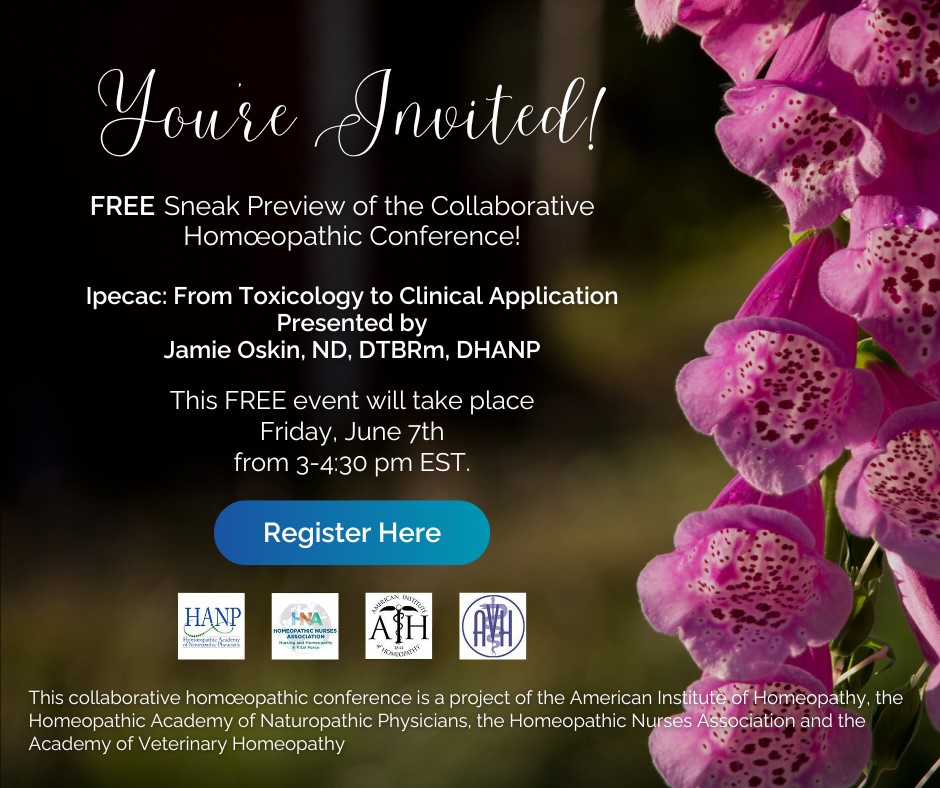
Written Comments to the FTC
EVALUATION OF EFFECTIVENESS OF HOMEOPATHIC MEDICINES
This position statement has been created to help provide guidance in the evaluation of homeopathic medicines using standard tools employed in conventional medicine. The American Institute of Homeopathy (AIH) is a national organization of physicians and other licensed health care providers with extensive training in both conventional and homeopathic medicine. This dual expertise makes the AIH unparalleled in its ability to provide guidance regarding the use of conventional evaluative approaches to the unique paradigm of homeopathic therapeutics. We have provided a brief overview of the current drug approval process for conventional therapeutics, reasoning for a different evaluative model that would be more appropriate to the homeopathic therapeutic system, and recommendations for future regulatory efforts.
Brief Overview of Current Drug Approval Mechanism in the United States
Currently, in the United States, the Center for Drug Evaluation and Research of the Food and Drug Administration (FDA) evaluates new drugs prior to release into the market to ensure the new products are safe and effective.1 In 1962, the requirement for the FDA to evaluate drugs marketed in the U.S. for effectiveness was added to the Federal Food, Drug, and Cosmetic Act by Congress. This amendment to the act defined substantial evidence of effectiveness as “evidence consisting of adequate and wellcontrolled investigations, including clinical investigations, by experts qualified by scientific training and experience to evaluate the effectiveness of the drug involved…”2 The FDA has generally interpreted this requirement to mean that at least two adequate and well-controlled trials are necessary to establish effectiveness. The primary tool for such evaluation is the Randomized Controlled Trial (RCT). A wellconducted RCT minimizes bias by controlling a number of variables in the subject population while approximating the expected treatment group in clinical practice. The RCT is a tool to demonstrate efficacy—the first step in demonstrating clinical effectiveness.
Clinicians rely on clinical practice guidelines derived from RCTs and systematic reviews to guide them in selecting the best therapy for an individual patient. Likewise, members of the public rely on FDA review as an assurance that a given over-the-counter (OTC) product will be effective for their particular health concern.
Homeopathic active ingredients are currently evaluated through a monograph process under the auspices of the Homoeopathic Pharmacopoeia Convention of the United States (HPCUS). Active ingredients with approved monographs have both prescription and OTC dosage levels set by the HPCUS within the published monograph. The HPCUS evaluates products for safety using available toxicology and safety data obtained from a thorough evaluation of numerous databases including Toxnet, International Agency for Research for Cancer (IARC), FDA website, and SwissMedic HAS List. Homeopathic medicines have a well-established safety record in clinical trials, reports from clinical practice, and in cases of accidental or intentional overdose.3,4,5,6,7 This data applies to both single homeopathic medicines and combination homeopathic products.
The potential effectiveness of homeopathic medicines is evaluated through a specialized clinical trial called a “proving”, which is a clinical trial conducted on healthy subjects to determine the clinical utility of a new homeopathic drug. Once a set of clinical indications is demonstrated in a proving, clinicians will begin a long process of verifying that results from the proving are relative to clinical conditions when that medicine is used in practice. Numerous case reports and expert consensus build into a collective database called the Repertory. Some homeopathic medicines are well verified medicines with a substantial number of published clinical reports of symptoms that have responded to the drug. Such medicines are found in commonly used homeopathic Materia Medicas and Repertories. Other less verified medicines have less than 20 published reports which may be the result of a suboptimal clinical picture that was produced in the proving or because the particular medicine is less frequently needed in clinical practice.
Why Homeopathic Experts Opine that RCTs are Inappropriate for Homeopathic Medicines
Experts in homeopathic research and clinical practice have long espoused the position that RCTs are an excellent tool for determining efficacy of allopathic (conventional) medicines, but are not well suited to evaluate homeopathic drugs. The reasons for this position rest on several points, as follows:
- Homeopathic medicines are individualized for a specific constellation of symptoms and observed clinical findings, not to the conventional diagnosis per se.
- Efficacy studies do not always predict effectiveness in clinical practice.
- Most homeopathic medicines already have a wealth of valid clinical data published in the homeopathic scientific literature.
- Homeopathic clinical data carries a high degree of reliability due to the outcome measures used.
To better understand these statements, let us look first at how homeopathic medicines are used. Individualization of homeopathic medicine use will vary according to the particular form of access to these medicines by the consumer. There are essentially three ways that consumers will access homeopathic medicines in the marketplace, as follows:
- Consumers who receive prescribed medicines from clinicians
- Consumers who have become well-informed about homeopathic medicine and partially individualize their own selection of OTC homeopathic products, and
- Consumers who have little or no knowledge of homeopathic medicine and use homeopathic products based upon a general indication.
These groupings are significant for how they use homeopathic medicines relative to the individualized nature of these drugs. Clinicians or prescribers treat both acute and chronic diseases. They often rely upon high degree of individualization of each treatment regimen. The specific constellation of symptoms corresponding to a homeopathic medicine is matched to the individual pathological state of the patient. Within any given diagnosis group of patients there may be multiple clinical patterns or constellations of symptoms that indicate different medicines. Sinusitis for example may have a number of medicines which show benefit for patients with different symptom patterns. The treatment course may consist of a single or multiple homeopathic medicines.
Consumers who are well-informed about homeopathic medicines will often use OTC products that have been formulated into combinations of homeopathic medicines targeted to one particular indication. Many of these consumers have accessed homeopathic information to help select more specific OTC products based upon the particular cluster or constellation of symptoms that they are experiencing for a self-limited problem. In this way, they may also select a single homeopathic medicine available OTC because they have a fair understanding of the specific use of that medicine.
In the third group, because these consumers are new to homeopathic medicine, they will tend to use combination products that are targeted to a particular indication. In this situation, individualized homeopathic medicines are combined according to their known usefulness for a specific indication.
While on the surface the approach to individualizing care and the use of a combination OTC product for more general indications may seem to be opposite approaches to care, the difference primarily reflects the nature of the conditions being treated. For chronic conditions, most clinicians prefer a single medicine or a combination of medicines that will treat a very specific array of symptoms as understood through clinical examination to best reflect the clinical state of the patient. When combination OTC products are designed, typically several medicines that have clinical evidence of being highly useful for a given condition are combined. These OTC products are marketed for acute and self-limited conditions. By combining multiple well-evaluated medicines for the condition, the likelihood of one or more of the medicines helping the condition is greatly increased. This approach is often used in conventional antibiotic therapy for severe infections prior to the identification of a precise organism.
Regarding the second point above, concerns arise for both consumers and prescribers when efficacy testing, for either homeopathic or allopathic drugs fail to translate into market safety or effectiveness. Products with RCTs that may have good internal validity, may fail to demonstrate external validity due to inaccurate translation to the population receiving treatment.
Most post-market drug failures and withdrawals are due to safety issues that arise in the larger population exposed to the product post-launch. However, some notable post-market failures have occurred due to lack of effectiveness including — Drotrecogin alfa (Xigris) 20118 and Gemtuzumab ozogamicin (Mylotarq) 20109
.
With respect to our third point, the homeopathic research process is primarily rooted in clinical data accumulation from pragmatic experiences of clinicians. Ultimate clinical effectiveness is best demonstrated in the clinical setting where medicines are used. Homeopathic clinical data has been collected over many years and then filtered for reliability and collated in the form of the Repertory and Materia Medica (texts that describe each medicine’s usefulness according to clinically verified symptoms). This clinical data has been carefully collected and published in the homeopathic literature. Multiple experts have painstakingly reviewed this literature to systematically remove less reliable data to enhance the overall external validity of these resources in their application in clinical practice. And finally as regards the fourth point, homeopathic clinical data is collected from those cases that produce clear effects in patients. While conventional medicine often uses endpoints related to palliation of a symptom, e.g. decreased pain or improved breathing, homeopathic medicine relies on the complete elimination of the symptoms, and overall improvement in health, as the outcome markers of preference. Homeopathic case data is reported when it has resulted in a well-documented, rapid, and dramatic cure of a symptomatic disorder of health. When data is drawn from treatment effects that demonstrate a rapid rate of improvement during treatment relative to the rate of improvement under non-treatment, the effect compared to background noise becomes very large.10 Because homeopathic case data is typically drawn from cases related to a sudden and stable change, bias and background noise can be ruled out without the need for RCTs. Such clinical data has also been used in conventional therapeutics. For example, insulin in diabetes, propranolol for infantile hemangiomas or neostigmine for myasthenia gravis are therapies whose effects in the clinical setting suggest that background noise is unlikely to be of significance.
In addition, using a global evaluation of wellness enhances the validation of improvement in the disorder. If the evaluation of efficacy reduces the outcome assessment to a single marker (as in many RCTs), the overall wellness of the individual may be lost as the primary objective which is of utmost importance to practitioners of homeopathic medicine.
The database of homeopathic literature is a large repository of patient-centered outcomes data. Case data filters in through various experts, becomes refined through inclusion in the Materia Medica under specific medicines, and ultimately gets collated, placed into a hierarchy, and standardized in the Repertory.
Recommendations:
- Although homeopathic medicines have an excellent safety record, HPCUS should continue to monitor new findings in relevant toxicology literature and update drug potency recommendations accordingly.
- At this time, all active ingredients currently in the HPUS should be considered as well verified medicines. All ingredients within the Homeopathic Pharmacopeia of the United States (HPUS) should be approved for OTC and Rx use within the attenuation guidance listed in the HPUS.
- Specifically for prescription homeopathic drugs – establish safe dosage for use based upon known toxicology. Because homeopathic medicines are historically very safe, allow all medicines for use as prescription drugs within attenuations set by HPCUS. Maximize availability of medicines to clinicians to encourage additional clinical verification (especially with regard to Less Verified medicines).
- Specifically for over-the-counter single ingredient homeopathic drugs – continue to make OTC homeopathic products available according to current regulations; but, limit indications according to those recognized, and verified, within source material acceptable to the HPCUS.
- Specifically for over-the-counter combination homeopathic drugs – any medicines currently OTC with combination products of well verified medicines that are being marketed for recognized self-limited indications from published homeopathic literature should be classified as Generally Recognized as Safe and Effective by the HPCUS.
- OTC medicines using ingredients that include less verified medicines (as defined by those medicines with substandard provings or lacking sufficient clinical data per the standards established by the HPCUS) should be required to attain additional clinical verification of those ingredients to further establish the effectiveness for the selected indication.
References
- Code of Federal Regulations; Title 21; Part 1316; Subchapter D(Drugs for Human Use);
- Federal Food, Drug & Cosmetic Act, Chapter V – Drugs and Devices, Subchapter A, Section 505 – New Drugs, paragraph (D), as amended by FDA Modernization Act of 1997.
- Dantas F, Rampes H. Do homeopathic medicines provoke adverse effects? A systematic review. Br Homeopath J. 2000 Jul;89 Suppl 1:S35-8.
- Bornhöft G, Matthiessen PF, editors. Homeopathy in Healthcare – Effectiveness, Appropriateness, Safety, Costs [Internet]. Berlin, Heidelberg: Springer Berlin Heidelberg; 2011 [cited 2015 Apr 28]. Available from http://link.springer.com/10.1007/978-3-642-20638-2
- Jong MC, Jong MU, Baars EW. Adverse drug reactions to anthroposophic and homeopathic solutions for injection: a systematic evaluation of German pharmacovigilance databases. Pharmacoepidemiol Drug Saf. 2012 Dec;21(12):1295-301.
- Posadzki P, Alotaibi A, Ernst E. Adverse effects of homeopathy: a systematic review of published case reports and case series. Int J Clin Pract. 2012 Dec;66(12):1178-88.
- Von Mach M-A, Habermehl P, Zepp F, Weilemann LS. [Drug poisonings in childhood at a regional poisons unit]. Klin Pädiatr. 2006 Feb;218(1):31-3.
- FDA Medwatch Safety Alerts for Human Medical Products. Posted 10/25/2011. Available online at http://www.fda.gov/Safety/MedWatch/SafetyInformation/SafetyAlertsforHumanMedicalProducts/ucm277143.htm Last accessed August 24, 2015.
- FDA Medwatch Safety Alerts for Human Medical Products. Posted 10/21/2010. Available online at http://www.fda.gov/Safety/MedWatch/SafetyInformation/SafetyAlertsforHumanMedicalProducts/ucm216458.htm Last accessed August 24, 2015.
- Glasziou P, Chalmers I, Rawlins M, McCulloch P. When are randomised trials unnecessary? Picking signal from noise. BMJ. 2007 Mar 3;334(7591):349-351.
Latest News & Updates
Latest Issue of the AJHM
AJHM – Winter 2023
Volume 116 Number 4
Table of Contents
- Editorial: In this Issue
- Homeopathic PuZZle?
- A Case of Erectile Dysfunction and Anejaculation in a Diabetic Patient
- Iron and Its Salts: Materia Medica and Illustration
- Suppression in the Organon
- An Appreciation of Jacques Jouanny’s Life and a Review of His Opus “The Essentials of Homeopathic Therapeutics”





